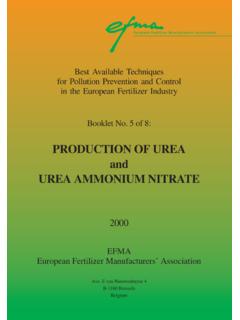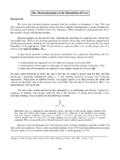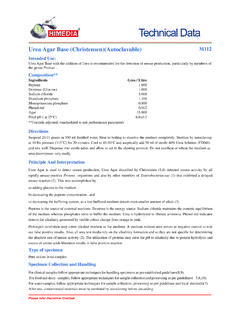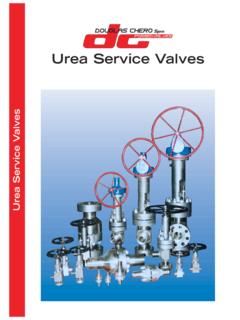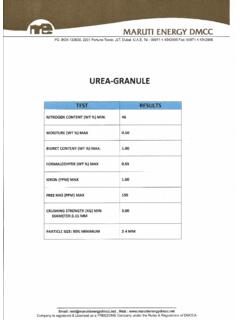Transcription of A technique for sanitizing sewage sludge Urea …
1 UPTEC W10 025 Examensarbete 30 hpJuni 2010A technique for sanitizing sewage sludge urea treatment with dual advantages En metod f r hygienisering av avloppsslam Ureabehandling med dubbla f rdelar Ida Sylwan I ABSTRACT A technique for sanitizing sewage sludge - urea treatment with dual advantages Ida Sylwan sewage sludge contains valuable plant nutrients, which to a higher degree than the current could be utilized in agriculture. First and foremost the phosphate contents in sewage sludge could be an important contribution in the highly productive and resource demanding agriculture of today. O nly around 15 % of the sewage sludge produced in Sweden is currently recycled to productive land.
2 There is in Sweden a political goal to recycle at least 60 % of the phosphorus in wastewater to productive land by 2015, as stated in the Swedish Environmental Objectives. In the future access to the currently most common phosphorus source in agriculture, easily mined phosphate minerals, is thought to decrease. Agricultural application of sewage sludge is however not an uncontroversial issue because of the contaminants, mainly heavy metals, contained in sludge . Pathogens are another concern. Upcoming legislation suggests sanitization requirements for sewage sludge used in agriculture. This has previously not been required and might thereby create a market for new solutions for sanitizing sludge .
3 The sanitization technique studied is addition of urea to sewage sludge . At sufficiently high concentrations ammonia becomes toxic to microorganisms. Achieving sanitization through urea treatment has previously been studied for various organic materials; such as source separated dry material, co-compost and single use biodegradable toilets. The method has in these studies been found effective. This study was designed for evaluating application of urea at the inlet of decanter centrifuges at sewage treatment plants, for the purpose of sanitization of the dewatered sludge . The sanitizing effect after application of urea to dewatered sludge was studied separately. The results indicate that addition of urea at the inlet of decanter centrifuges would cause a too high ammonia concentration in the reject water.
4 More than one fifth of the urea added ended up in the liquid effluent which corresponded to reject water. The expected increase in nitrogen load for sewage treatment plants was calculated to between 4 and 8 %. Addition of urea to dewatered sludge caused a clear decrease in studied pathogens. Approximations of the costs for sanitization of sludge by urea addition indicated that urea sanitization would be a low cost method compared to liming, pasteurization and thermophilic anaerobic digestion. Keywords: sanitization, urea , ammonia, sewage sludge , wastewater sludge , sludge treatment Department of energy and technology, SLU, Ulls v g 30 A, SE-756 51 Uppsala, Sweden ISSN 1401-5765 II REFERAT En metod f r hygienisering av avloppsslam - Ureabehandling med dubbla f rdelar Ida Sylwan Slam fr n reningsverk inneh ller v rdefulla v xtn rings mnen som i h gre utstr ckning skulle kunna utnyttjas i jordbruket.
5 F rst och fr mst r fosforresursen i slam v rdefull att ta till vara i dagens h gproduktiva och resurskr vande jordbruk. Idag anv nds endast kring 15 % av det avloppsslam som produceras i Sverige i jordbruket. Genom Milj m len har Sverige som politiskt m l att senast 2015 terf ra minst 60 % av fosforn i avlopp till produktiv mark. I framtiden tros tillg ngen till dagens st rsta fosfork lla, fosfatmineral av god kvalitet, komma att bli knapp. Slamanv ndning i jordbruk r dock ingen okontroversiell fr ga p grund av de f roreningar, fr mst tungmetaller, som avloppsslam inneh ller. Patogener r ett annat bekymmer. I en ny f rordning som f reslagits av Naturv rdsverket finns krav p att hygienisera avloppsslam innan anv ndning i jordbruk, n got som f r n rvarande inte kr vs.
6 Detta g r att marknaden f r hygieniseringsl sningar kan komma att v xa fram ver. Hygieniseringstekniken som studeras h r r tillsats av urea till slam. urea bryts efter inblandning i slam ner till ammoniak, som i tillr ckligt h ga koncentrationer r giftigt f r mikroorganismer. Hygienisering genom ureatillsats har tidigare studerats f r flera typer av organiska material, bland annat f r k llsorterade avloppsfraktioner, blandad kompost och f r nedbrytbara eng ngstoaletter. I dessa fall har metoden visat sig vara effektiv. I denna studie utv rderades tillsats av urea vid inloppet till dekantercentrifuger, med syfte att hygienisera det avvattnade slammet. Effekten av tillsats av urea till ett avvattnat slam unders ktes ocks separat.
7 Resultaten indikerar att tillsats av urea vid inloppet till dekantercentrifuger skulle orsaka en f r h g ammoniakkoncentration i rejektvattnet d mer n en femtedel av den tillsatta urean hamnade i v tskefasen efter separeringen. Kv vebelastningen p reningsverket f rv ntas enligt ber kningar ka med mellan 4 och 8 %. Tillsats av urea till avvattnat slam gav en klar minskning av patogena mikroorganismer. Ber kningar pekade p att hygienisering av avvattnat slam genom tillsats av urea skulle vara en billig hygieniseringsmetod j mf rt med kalkning, pasteurisering och termofil anaerob r tning. Nyckelord: hygienisering, urea , ammoniak, avloppsslam, slambehandling Institutionen f r energi och teknik, SLU, Ulls v g 30 A, SE-756 51 Uppsala, Sweden ISSN 1401-5765 III PREFACE This master thesis was performed at the Department of Energy and Technology at the Swedish University of Agricultural Sciences, Uppsala.
8 It was funded by a cluster group for research in the water and wastewater sector based in the M lardalen region. Supervising the work was associate professor Bj rn Vinner s and subject reviewer was Professor H kan J nsson, both at the Department of Energy and Technology at the Swedish University of Agricultural Sciences, Uppsala. I would like to thank my supervisor Bj rn Vinner s for your support and for introducing me to this topic. I would also like to thank all others that have contributed in the process. Among those Sahar Dalahmeh, Francesco Agostini, Evgheni Ermolaev and Annika Nordin who have all given me valuable advise during lab work. Further I would like to thank you who have answered my questionnaire regarding the sewage treatment plants in M lardalen; Roland Alsbro, Karri Jokinen and Lars-Gunnar Reinius.
9 The YARA urea used in experiments were sent to me free of charge and I would therefore like to thank Karin Hofko at YARA. I would like to express a special gratitude to Jesper O lsson at K ungs ngsverket sewage treatment plant who has answered my questions, aided me in sample collection and contributed with comments connected to the reality at the sewage treatment plant. Lastly I would like to thank Sofia Bryntse and Helena Magnusson for proof-reading my report and all of the staff at the Department of Energy and Technology for the pleasant company during this long white winter and beautiful spring. Ida Sylwan Uppsala, June 2010 Copyright Ida Sylwan and the Department of Energy and technology, SLU UPTEC W10 025, ISSN 1401-5765 Printed at the Department of Earth Sciences, Geotryckeriet, Uppsala University, Uppsala, 2010.
10 IV POPUL RVETENSKAPLIG SAMMANFATTNING Hygienisering av avloppsslam syftar till att minimera riskerna f r smittspridning d slammet anv nds i produktion av livsmedel eller som anl ggningsjord d r m nniskor kan komma i kontakt med jorden. I dagsl get finns flera bepr vade metoder f r hygienisering av avloppsslam, bland annat termofil r tning, kompostering, l ngtidslagring och kalkning. Ureabehandling r en ny metod i dessa sammanhang, men bygger p en princip som l nge varit k nd; urea omvandlas till ammoniak vid kontakt med slam och den ammoniak som bildas har en negativ verkan p patogena mikroorganismer. urea , ocks kallat urin mne, r v rldens vanligaste konstg dselmedel.

